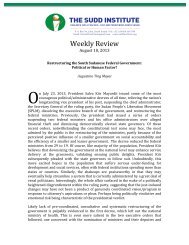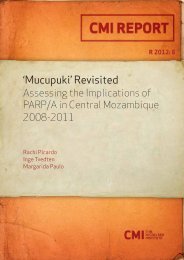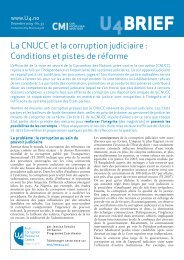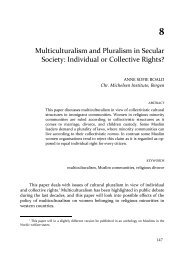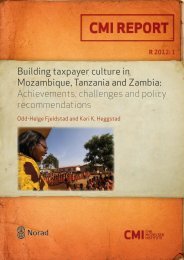- Page 1 and 2:
« GOVERNANCE Managing Public Expen
- Page 3 and 4:
Managing Public Expenditure A Refer
- Page 5 and 6:
FOREWORD This book fills an importa
- Page 7:
Foreword 5 could include senior off
- Page 10 and 11:
8 Managing Public Expenditure - A R
- Page 12 and 13:
10 Managing Public Expenditure - A
- Page 14 and 15:
12 Managing Public Expenditure - A
- Page 16 and 17:
14 Managing Public Expenditure - A
- Page 18 and 19:
16 Managing Public Expenditure - A
- Page 20 and 21:
18 Managing Public Expenditure - A
- Page 22 and 23:
20 Managing Public Expenditure - A
- Page 24 and 25:
22 Managing Public Expenditure - A
- Page 26 and 27:
24 Managing Public Expenditure - A
- Page 28 and 29:
26 Managing Public Expenditure - A
- Page 30 and 31:
28 Managing Public Expenditure - A
- Page 32 and 33:
30 Managing Public Expenditure - A
- Page 34 and 35:
32 Managing Public Expenditure - A
- Page 36 and 37:
34 Managing Public Expenditure - A
- Page 38 and 39:
36 Managing Public Expenditure - A
- Page 40 and 41:
38 Managing Public Expenditure - A
- Page 42 and 43:
40 Managing Public Expenditure - A
- Page 45 and 46:
CHAPTER 1 THE BUDGET AND ITS COVERA
- Page 47 and 48:
The Budget and its Coverage 45 Each
- Page 49 and 50:
The Budget and its Coverage 47 Obli
- Page 51 and 52:
The Budget and its Coverage 49 comm
- Page 53 and 54:
The Budget and its Coverage 51 Many
- Page 55 and 56:
The Budget and its Coverage 53 When
- Page 57 and 58:
The Budget and its Coverage 55 Box
- Page 59 and 60:
The Budget and its Coverage 57 Gene
- Page 61 and 62:
The Budget and its Coverage 59 the
- Page 63 and 64:
The Budget and its Coverage 61 Tax
- Page 65 and 66:
The Budget and its Coverage 63 NOTE
- Page 67 and 68:
66 Managing Public Expenditure - A
- Page 69 and 70:
68 Managing Public Expenditure - A
- Page 71 and 72:
70 Managing Public Expenditure - A
- Page 73 and 74:
72 Managing Public Expenditure - A
- Page 75 and 76:
74 Managing Public Expenditure - A
- Page 77 and 78:
76 Managing Public Expenditure - A
- Page 79 and 80:
78 Managing Public Expenditure - A
- Page 81 and 82:
80 Managing Public Expenditure - A
- Page 83 and 84:
82 Managing Public Expenditure - A
- Page 85 and 86:
84 Managing Public Expenditure - A
- Page 88 and 89:
CHAPTER 3 THE EUROPEAN BUDGET AND T
- Page 90 and 91:
Table 3.1. FINANCIAL PERSPECTIVE 20
- Page 92 and 93:
The European Budget and the Impact
- Page 94 and 95:
The European Budget and the Impact
- Page 96 and 97:
The European Budget and the Impact
- Page 98 and 99:
The European Budget and the Impact
- Page 100 and 101:
The European Budget and the Impact
- Page 102 and 103:
The European Budget and the Impact
- Page 104 and 105:
The European Budget and the Impact
- Page 106 and 107:
The European Budget and the Impact
- Page 108 and 109:
The European Budget and the Impact
- Page 110 and 111:
The European Budget and the Impact
- Page 112:
The European Budget and the Impact
- Page 115 and 116:
114 Managing Public Expenditure - A
- Page 117 and 118: 116 Managing Public Expenditure - A
- Page 119 and 120: 118 Managing Public Expenditure - A
- Page 122 and 123: CHAPTER 4 BUDGET CLASSIFICATION, PR
- Page 124 and 125: Budget Classification, Presentation
- Page 126 and 127: Budget Classification, Presentation
- Page 128 and 129: Budget Classification, Presentation
- Page 130 and 131: Budget Classification, Presentation
- Page 132 and 133: Budget Classification, Presentation
- Page 134 and 135: Budget Classification, Presentation
- Page 136 and 137: Budget Classification, Presentation
- Page 138 and 139: Budget Classification, Presentation
- Page 140 and 141: Budget Classification, Presentation
- Page 142 and 143: Budget Classification, Presentation
- Page 144 and 145: CHAPTER 5 POLICY FORMULATION AND BU
- Page 146 and 147: Policy Formulation and Budget Prepa
- Page 148 and 149: Policy Formulation and Budget Prepa
- Page 150 and 151: Policy Formulation and Budget Prepa
- Page 152 and 153: Policy Formulation and Budget Prepa
- Page 154 and 155: Policy Formulation and Budget Prepa
- Page 156 and 157: Policy Formulation and Budget Prepa
- Page 158 and 159: Policy Formulation and Budget Prepa
- Page 160 and 161: Policy Formulation and Budget Prepa
- Page 162 and 163: Policy Formulation and Budget Prepa
- Page 164 and 165: Policy Formulation and Budget Prepa
- Page 166 and 167: Policy Formulation and Budget Prepa
- Page 170 and 171: Policy Formulation and Budget Prepa
- Page 172 and 173: Policy Formulation and Budget Prepa
- Page 174 and 175: Policy Formulation and Budget Prepa
- Page 176 and 177: 176 Managing Public Expenditure - A
- Page 178 and 179: 178 Managing Public Expenditure - A
- Page 180 and 181: 180 Managing Public Expenditure - A
- Page 182 and 183: 182 Managing Public Expenditure - A
- Page 184 and 185: 184 Managing Public Expenditure - A
- Page 186 and 187: 186 Managing Public Expenditure - A
- Page 188 and 189: 188 Managing Public Expenditure - A
- Page 190 and 191: 190 Managing Public Expenditure - A
- Page 192 and 193: 192 Managing Public Expenditure - A
- Page 194 and 195: 194 Managing Public Expenditure - A
- Page 196 and 197: 196 Managing Public Expenditure - A
- Page 198 and 199: 198 Managing Public Expenditure - A
- Page 200 and 201: 200 Managing Public Expenditure - A
- Page 202 and 203: 202 Managing Public Expenditure - A
- Page 204 and 205: 204 Managing Public Expenditure - A
- Page 206: PART III MANAGING BUDGET EXECUTION
- Page 209 and 210: 210 Managing Public Expenditure - A
- Page 211 and 212: 212 Managing Public Expenditure - A
- Page 213 and 214: 214 Managing Public Expenditure - A
- Page 215 and 216: 216 Managing Public Expenditure - A
- Page 217 and 218: 218 Managing Public Expenditure - A
- Page 219 and 220:
220 Managing Public Expenditure - A
- Page 221 and 222:
222 Managing Public Expenditure - A
- Page 223 and 224:
224 Managing Public Expenditure - A
- Page 225 and 226:
226 Managing Public Expenditure - A
- Page 227 and 228:
228 Managing Public Expenditure - A
- Page 229 and 230:
230 Managing Public Expenditure - A
- Page 231 and 232:
232 Managing Public Expenditure - A
- Page 233 and 234:
234 Managing Public Expenditure - A
- Page 235 and 236:
236 Managing Public Expenditure - A
- Page 237 and 238:
238 Managing Public Expenditure - A
- Page 240 and 241:
CHAPTER 9 THE TREASURY FUNCTION AND
- Page 242 and 243:
The Treasury Function and Cash Mana
- Page 244 and 245:
The Treasury Function and Cash Mana
- Page 246 and 247:
The Treasury Function and Cash Mana
- Page 248 and 249:
The Treasury Function and Cash Mana
- Page 250 and 251:
The Treasury Function and Cash Mana
- Page 252 and 253:
The Treasury Function and Cash Mana
- Page 254 and 255:
The Treasury Function and Cash Mana
- Page 256:
The Treasury Function and Cash Mana
- Page 259 and 260:
260 Managing Public Expenditure - A
- Page 261 and 262:
262 Managing Public Expenditure - A
- Page 263 and 264:
264 Managing Public Expenditure - A
- Page 265 and 266:
266 Managing Public Expenditure - A
- Page 267 and 268:
268 Managing Public Expenditure - A
- Page 269 and 270:
270 Managing Public Expenditure - A
- Page 271 and 272:
272 Managing Public Expenditure - A
- Page 273 and 274:
274 Managing Public Expenditure - A
- Page 275 and 276:
276 Managing Public Expenditure - A
- Page 277 and 278:
278 Managing Public Expenditure - A
- Page 280 and 281:
SUMMARY — PART III A. KEY POINTS
- Page 282 and 283:
Summary — Part III — Managing B
- Page 284 and 285:
Summary — Part III — Managing B
- Page 286:
Summary — Part III — Managing B
- Page 290 and 291:
CHAPTER 11 ACCOUNTING Accounting an
- Page 292 and 293:
Accounting 293 paid and, more gener
- Page 294 and 295:
Accounting 295 Figure 11.1. CASH AN
- Page 296 and 297:
Accounting 297 eventually a commitm
- Page 298 and 299:
Accounting 299 3. Expenses a. Main
- Page 300 and 301:
Accounting 301 Such an assessment c
- Page 302 and 303:
Accounting 303 • Implementation o
- Page 304 and 305:
Accounting 305 information on commi
- Page 306 and 307:
Accounting 307 The consolidation mo
- Page 308 and 309:
Accounting 309 Table 11.2. PLANS TO
- Page 310 and 311:
Accounting 311 Box 11.2. COMPARISON
- Page 312 and 313:
Accounting 313 4. Capital charges T
- Page 314:
Accounting 315 15. A generation is
- Page 317 and 318:
318 Managing Public Expenditure - A
- Page 319 and 320:
320 Managing Public Expenditure - A
- Page 321 and 322:
322 Managing Public Expenditure - A
- Page 323 and 324:
324 Managing Public Expenditure - A
- Page 325 and 326:
326 Managing Public Expenditure - A
- Page 327 and 328:
328 Managing Public Expenditure - A
- Page 329 and 330:
330 Managing Public Expenditure - A
- Page 331 and 332:
332 Managing Public Expenditure - A
- Page 333 and 334:
334 Managing Public Expenditure - A
- Page 335 and 336:
336 Managing Public Expenditure - A
- Page 337 and 338:
338 Managing Public Expenditure - A
- Page 339 and 340:
CHAPTER 14 EXTERNAL AUDIT Auditing,
- Page 341 and 342:
External Audit 343 Box 14.1. RECOMM
- Page 343 and 344:
External Audit 345 Independence of
- Page 345 and 346:
External Audit 347 (but not always)
- Page 347 and 348:
External Audit 349 2. Ex post audit
- Page 349 and 350:
External Audit 351 Such audits can
- Page 351 and 352:
External Audit 353 Box 14.4. FRANCE
- Page 353 and 354:
External Audit 355 Box 14.6. UNITED
- Page 355 and 356:
External Audit 357 government offic
- Page 357 and 358:
CHAPTER 15 PERFORMANCE MEASUREMENT
- Page 359 and 360:
Performance Measurement and Evaluat
- Page 361 and 362:
Performance Measurement and Evaluat
- Page 363 and 364:
Performance Measurement and Evaluat
- Page 365 and 366:
Performance Measurement and Evaluat
- Page 367 and 368:
Performance Measurement and Evaluat
- Page 369 and 370:
Performance Measurement and Evaluat
- Page 371 and 372:
Performance Measurement and Evaluat
- Page 373 and 374:
Performance Measurement and Evaluat
- Page 375 and 376:
Performance Measurement and Evaluat
- Page 377 and 378:
Performance Measurement and Evaluat
- Page 379 and 380:
Performance Measurement and Evaluat
- Page 381 and 382:
SUMMARY — PART IV A. KEY POINTS 1
- Page 383 and 384:
Summary — Part IV — Accounting,
- Page 385 and 386:
Summary — Part IV — Accounting,
- Page 387 and 388:
ANNEX I QUESTIONNAIRE ON PUBLIC EXP
- Page 389 and 390:
Questionnaire on Public Expenditure
- Page 391 and 392:
Questionnaire on Public Expenditure
- Page 393 and 394:
Questionnaire on Public Expenditure
- Page 395 and 396:
Questionnaire on Public Expenditure
- Page 397 and 398:
Questionnaire on Public Expenditure
- Page 399 and 400:
Questionnaire on Public Expenditure
- Page 401 and 402:
Questionnaire on Public Expenditure
- Page 403 and 404:
Questionnaire on Public Expenditure
- Page 405 and 406:
Questionnaire on Public Expenditure
- Page 407 and 408:
Questionnaire on Public Expenditure
- Page 409 and 410:
Questionnaire on Public Expenditure
- Page 411 and 412:
ANNEX II ESTABLISHMENT OF A NATIONA
- Page 413 and 414:
Establishment of a National Fund Sy
- Page 415 and 416:
Establishment of a National Fund Sy
- Page 417 and 418:
Establishment of a National Fund Sy
- Page 419 and 420:
Establishment of a National Fund Sy
- Page 421 and 422:
424 Managing Public Expenditure - A
- Page 423 and 424:
426 Managing Public Expenditure - A
- Page 425 and 426:
428 Managing Public Expenditure - A
- Page 428 and 429:
ANNEX IV IMF CODE OF GOOD PRACTICES
- Page 430 and 431:
IMF Code of Good Practices on Fisca
- Page 432:
IMF Code of Good Practices on Fisca
- Page 435 and 436:
438 Managing Public Expenditure - A
- Page 437 and 438:
440 Managing Public Expenditure - A
- Page 439 and 440:
442 Managing Public Expenditure - A
- Page 441 and 442:
444 Managing Public Expenditure - A
- Page 443 and 444:
446 Managing Public Expenditure - A
- Page 445 and 446:
448 Managing Public Expenditure - A
- Page 447 and 448:
450 Managing Public Expenditure - A
- Page 449 and 450:
452 Managing Public Expenditure - A
- Page 451 and 452:
454 Managing Public Expenditure - A
- Page 453 and 454:
456 Managing Public Expenditure - A
- Page 455 and 456:
458 Managing Public Expenditure - A
- Page 457 and 458:
460 Managing Public Expenditure - A
- Page 459 and 460:
462 Managing Public Expenditure - A
- Page 461 and 462:
464 Managing Public Expenditure - A
- Page 463 and 464:
466 Managing Public Expenditure - A
- Page 465 and 466:
468 Managing Public Expenditure - A
- Page 467 and 468:
470 Managing Public Expenditure - A
- Page 469 and 470:
472 Managing Public Expenditure - A
- Page 471 and 472:
BIBLIOGRAPHY Abed, George T. (1998)
- Page 473 and 474:
Bibliography 477 Canada, Ministry o
- Page 475 and 476:
Bibliography 479 Goode, Richard (19
- Page 477 and 478:
Bibliography 481 Kopits, George and
- Page 479 and 480:
Bibliography 483 OECD (1996c). Perf
- Page 481 and 482:
Bibliography 485 Rajcoomar, S., Mic
- Page 483 and 484:
Bibliography 487 Squire, Lyn. (1995
- Page 485 and 486:
Bibliography 489 United States, Gen
- Page 487 and 488:
SELECTED WORLDWIDE WEB SITES 1 http
- Page 489 and 490:
INDEX Note: For terms listed in the
- Page 491 and 492:
Index 495 ex post control: 124, 262
- Page 493 and 494:
Index 497 GAAP: 13, 384, 456 genera
- Page 495 and 496:
Index 499 Pre-Accession Economic Pr
- Page 497:
OECD PUBLICATIONS, 2, rue André-Pa



